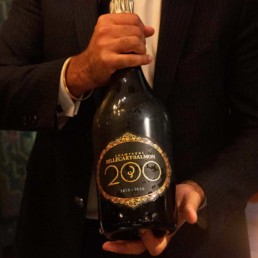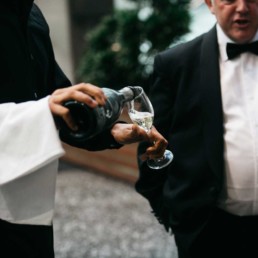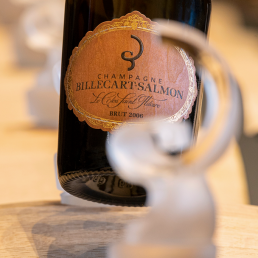Dhall & Nash Wondermaker
Champagne Billecart-Salmon
The Art of Fine Champagne
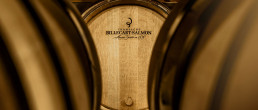
This month’s Wondermaker, Billecart-Salmon is all about Champagne.
“Billecart-Salmon is in the very top echelon of Champagne houses – it is one of only four awarded the 10/10 rating”
Tyson Stelzer, Acclaimed Champagne Specialist
Champagne. How much magic is in this word – the ultimate luxury libation – the supernova of sparkling wines? Not all champagne is created equal – if you get our drift!
Perhaps we too readily acquiesce to having a glass of the mass produced champagnes of the world like the Moëts, the Veuves, the Mumms… STOP! We dare you to be different this holiday season.
For many years now, Dhall & Nash has been incredibly fortunate and honoured to represent the best of the little guy Champagne Houses, the esteemed Billecart-Salmon. They are Prestigious with a capital P!
So, it’s about time we proselytised to the last few unconverted about the hedonistic, artfully executed, stunningly textured Billecart-Salmon range of superb champagnes. Are you ready to take it up a few notches for your summer festivities and beyond?
And if reviews are your thing, go take a look at the effusive praise Billecart-Salmon receives then try to keep your jaw from hitting the ground when you find some flirting with the ever-elusive triple-digit score. Is it expensive? Yes. Is it worth it? Absolutely, positively, 100%.
“The mark of Billecart is made not by the heavy footfall of concentration, power and presence, but rather the fairy touch of delicacy and crystal-clear fidelity.”
Tyson Stelzer, Acclaimed Champagne Specialist
A Champagne House with Finesse
The History of Billecart-Salmon
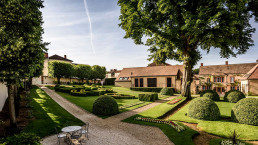
Situated in the Champagne heartland of Mareuil-sur-Aÿ, near Epernay, Billecart-Salmon has been under family ownership and management since its founding in 1818. It is a family-run winery with a majority share owned by the Billecart family and a minority holding is held by the Frey group, itself a family-owned business – they are owners of Château La Lagune in Bordeaux, Paul Jaboulet Ainé in the Rhône, and Château Corton C in Burgundy.
The Billecart family still lives on site and there remains a strong sense of long-visioned family continuity at play. Today there’s the seventh generation Mathieu Roland-Billecart overseeing everyday business as CEO, working closely with Antoine and François.
“If there is a bartender favourite it is perhaps Billecart Salmon – not just because it’s fine fizz but because it’s a medium-sized house still under family control.”
Drinks International
During the 17th century, Pierre Billecart, an esteemed winemaker of the era, and ancestor of Nicolas François Billecart, was summoned by King Louis XIII who authorised him to create his own coat of arms. Thus, when the Champagne House of Billecart-Salmon was born in 1818 from the marriage of Nicolas-François Billecart and Elisabeth Salmon, his descendants proudly reinstated them. Appropriately a royal seal of approval as the foundation for the new champagne House. And remarkably, both sides of each family can trace their roots back to the village of Mareuil-sur-Aÿ as far back as the 16th century.
It was Elizabeth’s brother, Louis Salmon, who took charge of the oenological side of the business, while Nicolas François, a lawyer by training, developed the commercial side.
Billecart-Salmon prospered throughout the 19th century until the intervention of the First World War in 1914. By the end of the war, the 100-year-old house was down to just 75,000 bottles remaining in the cellars. However, the company got through relatively unscathed and Charles Roland-Billecart managed to restore sales to around 217,000 bottles by 1936.
Always conscious of improving the quality of their champagne, in 1958 they developed a winemaking method that was revolutionary for the time (Geek Talk on this later). This new technique meant that over time, the wines conserve their crystalline freshness, and the aromas intensify, allowing Billecart-Salmon champagnes to deliver all they promise.
In 1964, as a tribute to founder Nicolas François, the house launched the first vintage of the eponymous Cuvée Nicolas François. In 1999, the Cuvée Nicolas François Billecart Vintage 1959 was chosen “Champagne of the Millennium” by a committee of experts at a blind tasting session involving 150 vintages from the most illustrious champagne producers, organised in Stockholm by Richard Juhlin, a great champagne specialist. Amazingly, the 1961 vintage of Cuvée Nicolas François, came second. Double Wow!
Even if two centuries have passed since the creation of Billecart-Salmon champagnes, its motto remains unchanged: ‘‘Give priority to quality, strive for excellence”
Billecart-Salmon
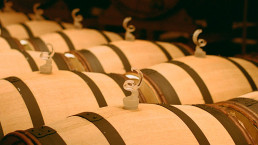
Ever the trend-setters, in 1970, Jean Roland-Billecart, the then company president, decided to develop a rosé Champagne at a time when this type of Champagne was not considered high quality. This move changed the face of champagne forever.
Today, the Billecart-Salmon non-vintage rosé is the gold standard for every champagne house making rosé.
“Billecart [] has a particularly and deservedly high reputation for its Brut Rosé”
Jancis Robinson MW
By the early 1990s, the house repositioned itself as a premium brand, focusing on high end restaurants and exclusive retailers. In keeping with this revitalisation, in 1995, the house decided to isolate one-hectare of its most valued vineyard to be vinified separately. This became the first vintage of Clos St-Hilaire, a 100% Pinot Noir Blanc de Noirs vinified directly on site (very rare in Champagne) and aged in barrels.
Billecart-Salmon’s Le Clos Saint-Hilaire is “the King of Blanc de Noirs, [] a towering masterpiece of profound mineral clarity and unfathomable complexity.”
Tyson Stelzer, Champagne Specialist
Style and Uniqueness
The Continuing Quest for Excellence
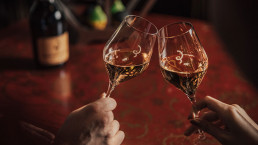
In 1996, François Roland-Billecart decided to re-introduce oak as a major component in the making of their wine. This widened the range of available aromas for blending by the Chief Winemaker. As for all the techniques used by the House, the oak casks, and more recently large oak barrels, have been selected with great care by the Vineyard Master. The vinification in steel tanks combined with that in oak casks enhance the wines of the House. As always, the goal at Billecart, is to encourage subtle refined complexity rather than any overt oak character.
Another unique factor lies at the root of the specific Billecart-Salmon style: time. Unlike the legal minimum required for Champagne wines – 15 months for non-vintage wines and 36 months for vintage wines – Billecart-Salmon bottles are laid down for a minimum of between 3 and 10 years in its chalk cellars before they are judged ready for tasting and release.
Billecart-Salmon is discreetly but significantly continuing to evolve. With the new millennium came the construction of a new cuverie, enabling better control of individual parcels in small temperature controlled tanks. This was followed in 2010 by the addition of a new Chai housing 400 small and two large oak foudres. Since 2018 another cellar is home to oak foudres retaining some 80,000 litres of reserve wine.
Meanwhile, Billecart’s wines are spending longer and longer sur lees, and fruit sourcing is changing—with more grand cru fruit replacing premier cru fruit—while volumes remain the same. Based on the trials underway in their emblematic Clos Saint-Hilaire, the next frontier will be the vineyards.
Billecart-Salmon “…is going from strength to strength.”
William Kelley, Robert Parker’s The Wine Advocate
Billecart-Salmon And Gastronomy: An Alliance of Taste
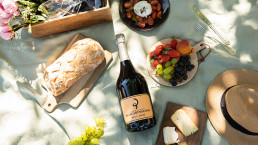
Billecart-Salmon has built its reputation partly through its association with fine dining and haute cuisine. The House owes this to François Roland-Billecart, who, as a watchful observer, understood in the early 1990s, that champagne had ceased to be merely a wine and had become the signature of an image. Thus, the only future imaginable for a small house like Billecart-Salmon was to encompass wine experiences of the highest quality. From that point on, with the help of Alexandre Bader, the current Managing Director, Billecart-Salmon pivoted towards a defining relationship with haute cuisine becoming the champagne served in all 27 Michelin-starred restaurants in France. What a coup!
“It’s easy to work for a company that is searching for quality as the goal across the whole process. The best grapes on the best terroirs are expensive, but this is our priority.”
François Domi, Retired Chef de Cave
Hands-on In the Vineyards
Grapes from the Best Crus in Champagne
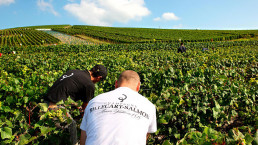
The excellence of Billecart-Salmon champagnes rests, above all, on the knowledge of those who rigorously select grapes from vineyards of more than 300 hectares, of which about 100 hectares belong to the House and its shareholders, divided between 40 different Champagne crus. The House also manages under lease arrangement, 80 hectares of grand cru fruit, taking full control from pruning to harvest. Overall, Billecart-Salmon has 52% Grand Cru fruit, 16% Premier Cru.
Fortunately, most grapes used for winemaking come from a radius of 20km around Epernay, where the great wines of Pinot Noir, Chardonnay and Pinot Meunier from the Montagne de Reims, Côte des Blancs and the Vallée de la Marne are to be found.
Billecart-Salmon is certified « High Environmental Value » and in 2017, was awarded the «Sustainable Viticulture in Champagne» certification for its winemaking
Billecart-Salmon’s trials with biodynamics and permaculture were begun in the Clos St Hilaire plot. CEO Mathieu Roland-Billecart describes the one-hectare parcel as his research and development facility. It is here, in a controlled, manageable environment where the estate seeks not only to better its understanding of soil and climate but also to trial new practices and establish advancements in viticulture. He describes the current viticulture as “organic plus”. There is ploughing by horses, sheep graze the grass, and there are bees. Though a large percentage of the house’s vineyards are farmed organically, the estate is not organic in its entirety.
Mathieu says he sees great hope for permaculture, but a lot depends on the size of the parcel. In Champagne, the average size is 0.13 hectares, so this can be a problem. ‘We don’t believe in the one size fits all approach,’ he says. ‘It is parcel by parcel: some vineyards are more capable of dealing with organics than others.’ They no longer use herbicides, and whether or not they plough depends on the plot.
‘Billecart-Salmon are deeply committed to the preservation of the link between man and nature’
Billecart-Salmon Website
The Billecart-Salmon Philosophy
The House’s philosophy is simple: respect the terroir in order to produce great wines.
Mathieu Roland-Billecart, explains: “Billecart-Salmon experiments all the time, whether it’s in the vineyard or in our vinification process. What that means is that we try new things to further improve the quality wherever we can. The vast amount of these experiments you never see. Because if they are successful, and very often they are, they end up being kept in our reserve wine catalogue, so they help us to further improve the quality of our wines, which in time means that they improve the quality of our non-vintage Champagnes, whether that is Brut Réserve, Brut Sous Bois, Brut Rosé, etc.”
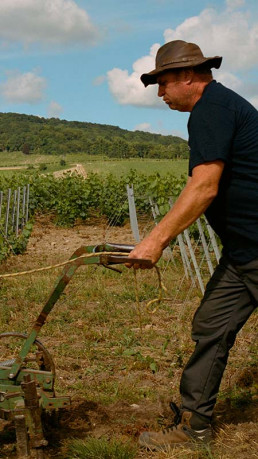
Billecart-Salmon’s Commitment to Sustainable Viticulture
In its constant quest for excellence, Billecart-Salmon favours cultivation methods that aim to protect the environment and promote biodiversity. Committed to preserving the cycle between winemaker and nature, the House has long been convinced that such a course of action is essential in the pursuit of environmental sustainability.
Long before being certified High Environmental Value (HVE) and Sustainable Viticulture in Champagne (VDC) in 2017, Maison Billecart-Salmon was already focused on managing its vineyards with the utmost respect for the environment. Beyond a simple approach, it’s a long-term state of mind that calls for constant self-assessment and continuous progress.
VDC
Sustainable Viticulture in Champagne. A fervent advocate of this ecological approach, Maison Billecart-Salmon is raising awareness among partner winegrowers about the importance of the certification through its certification collective. In 2021, 75% of its supplies are VDC certified.
HVE
This is environmental certification at the highest level with 4 indicators considered: biodiversity, fertilization, phytosanitary protection, and water management.
Vinification – Meticulous Work
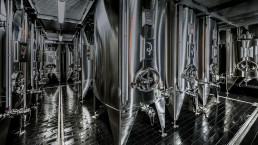
‘When modernity and authenticity unite in the best way’
Billecart-Salmon Website
As part of the ever present quest to maintain the quality of their champagnes, in the fifties, Billecart-Salmon developed the most revolutionary technique of double debourbage.
Essentially, after the standard clarification process to settle out solids, the juice is settled a second time at 4degrees Celsius for a minimum of 48 hours. The house pioneered this system. Inspired by the maternal grandfather’s experience brewing beer no less!
What happens is this – at this temperature, the coarser lees are removed without risk of oxidation, delivering pristine juice perfect for fermentation. The process is expensive and time-consuming. Fellow vignerons thought they were crazy.
The juice is then brought up to just 13 degrees C for the primary fermentation. All 100 tanks are individually temperature controlled. At this temperature, cultured yeasts from the natural yeasts of nearby villages take 3-4 weeks to complete fermentation. Such long cool ferments are crucial for retaining greater freshness and delicacy than a standard champagne ferment of one week at 20°C.
The cuverie (winery building) concentrates primarily on small thermoregulated cuvees (47 hectolitres) which allows the House to observe the traceability of the grape varieties and the individual parcels. This vinification is carried out cru by cru and grape variety by grape variety which permits the conservation of the nuances of expression of the terroir. In vinifying at a low temperature, the fermentation process slows down, encouraging ethereal aromas, which are delicate and allow all the purity of the fruit to be expressed. It is the absolute signature of the Billecart-Salmon style.
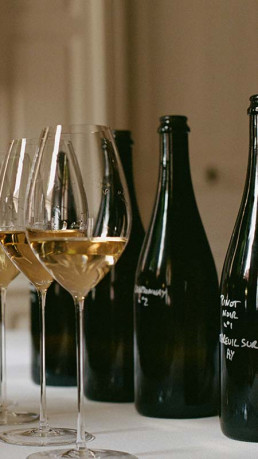
“Overall, they [Billecart-Salmon] are rather subtle and low key. They say that while most other houses aim for: a fizziness quotient of about seven atmospheres, they deliberately aim for six.”
Jancis Robinson, MW
This is also one of the few champagne houses where some of the top wines are still hand-riddled. But, Mathieu Roland-Billecart insists, there are no rules. Neither for cork v crown cap, malo, nor dosage. Decisions are taken on a wine by wine basis. Though they are very keen on the quality of the liqueur d’expedition, added to top up the wine after disgorgement. So, for a final nuance: every cuvee has a different liqueur at Billecart. Chef de Cave, Florent Nye conducts many tastings with different dosages, from wines aged in barrel and those in tank, to determine which best suits each wine. “The wine is in a constant state of evolution” explains Antoine Roland-Billecart.
Low dosage is also a Billecart signature – over the past decade decreasing the dosage has been crucial in allowing the fruit to show its full character. Antoine says, “It’s like make-up, you don’t need it if there is no problem, and you want to show the real character of the wines”.
Billecart-Salmon has chalk cellars dating from the 17th and 19th centuries meandering for kilometres beneath the cuverie standing guard over the House’s precious cargo. Over time, the wines assert themselves and the aromas develop, imprinted with all the finesse, balance and elegance which are characteristic of the personality of the House’s champagnes.
Billecart-Salmon is famously slow to release wines – with over three to four years in cellars the non-vintage champagnes really blossom, staying around twice as long as the fixed regulations of the appellation. The vintage cuvées patiently wait ten years before they begin to reveal their maturity. Allowing time to play its role is behind the grandeur of all Billecart-Salmon champagnes.
An Instinct for Wine

At Billecart-Salmon, instinct alone inspires wine. It is an instinct transmitted from generation to generation that is to be found in abundance in the House tasting committee. Bringing together three generations of the family as well as the head winemakers, the committee comprises: Jean, François, Antoine and Mathieu Roland-Billecart and Florent Nys, Denis Blée and François Domi. Together, they decide on the selection of wines, blends, and dosages to be made. Step by step, the committee tastes, informs and adjusts each wine, satisfied only when they are all in agreement. Whether they are leaders, cellar masters, oenologists, or winemakers, they all share a passion for wine and are careful to preserve the certain style that is Billecart-Salmon. Altogether ensuring the calibre and legacy of this unique Champagne House continues.
The Artful Billecart-Salmon Champagnes
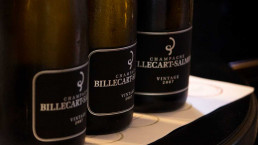
The 200-year old Billecart Salmon Champagne house has never failed to impress wine drinkers and critics – thanks to consistent innovations in winemaking, commitment to quality and the impressive line-up of cuvees!
When wine critic Tyson Stelzer asked Antoine Roland-Billecart how they maintain such transcendental standards in every one of their cuvées, his refreshingly honest reply was: “We are not focused on marketing. Vinification is the key for us, and all the rest is bullshit!” Say no more.
Although the Billecart-Salmon portfolio is vast, they are best known for their prestige founders’ cuvées, Cuvée Nicolas-François, Cuvée Elisabeth Salmon Rosé, and Cuvée Louis Salmon. The ultimate jewel of the estate, however, is the single-vineyard champagne Clos Saint Hilaire: a monstrously powerful Blanc de noir cuvée.
Over the decades, there have been so many glowing reviews with stratospheric scores making them impossible to list here, however, some salient descriptors will give you an inkling of their Best-in-Show status:
“An ethereal champagne”, “richness plus transparency”, “brimming with light”, “very pure, very fresh, very zesty”, “refreshing balance”, “high-toned”, “racy & lively”, “a peacock’s tail finish”, “very confident”, “transparent & delicate”, “very flirtatious”, “polished texture”, “an elixir”, “firm & quite structured”, “elegance & expressive fruit”, “a study in subtlety”, “beautifully chiselled finesse”, “perfect & complex maturity”, “persistent & fascinating effervescence”, “mouth-filling concentration”, “Full-bodied yet agile, “pillowy & layered” and many more.
“I tasted 18 current non-vintage cuvées of the most famous champagne houses last week blind – a rare treat – and Billecart-Salmon Brut Réserve was the most impressive for me.”
Jancis Robinson MW
Which Billecart-Salmon bottles should you not miss out on for Christmas and for 2023?
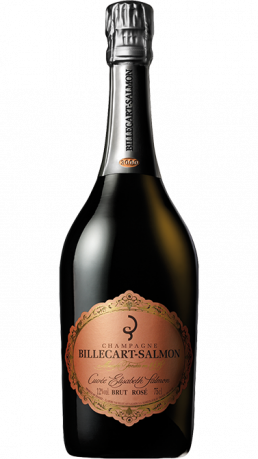
Billecart-Salmon Cuvée Elisabeth Salmon 2009
Depth and Complexity
Copper-orange color with aromas of grapefruit pith, cherry stones, dried roses, white pepper, pastries, walnuts, and oyster shells. Refined and elegant with pretty, dried red and citrus fruit, layered with subtle spice and toast. Fine bubbles. Dry. 55% pinot noir from Mareuil-sur-Ay and Ay, and 45% Grand Cru chardonnay from Cote des Blancs, with 10% of pinot noir red wine. Dosage 7g/L. Disgorged in July 2021. Drink or hold.
96 points – James Suckling
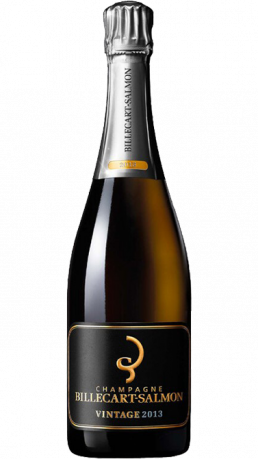
Billecart-Salmon 2013 Vintage
Intense and Seductive
A vibrant Champagne, finely balanced and lacy in texture, serving as an elegant canvas for layered flavours of yellow peach, chopped almond, cherry, toast point and preserved lemon. Minerally smoke, chalk and spice notes play on the finish. Disgorged November 2021. Drink now through 2030.
94 points – Wine Spectator
“This is one of those champagnes that is really joyful, happy, and upbeat, with real vivaciousness yet quite a bit of serious undertow too.”
Jancis Robinson MW on Billecart-Salmon Grand Cru Blanc de Blancs NV
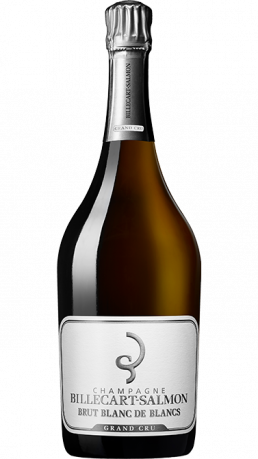
Billecart-Salmon Blanc de Blancs Brut Grand Cru NV
Delicacy & Elegance
Produced from the grapes of five grand cru vineyards of the Côte des Blancs: Avize, Chouilly, Cramant, Mesnil-sur-Oger and Oger, this beautiful Champagne is crisp and mineral, with a great texture and acidity. It has elegance and style as well. It is a finely balanced wine that is ready to drink.
93 points – Wine Enthusiast
Based on the 2015 vintage and dominated this year by Mesnil sur Oger, Billecart’s NV Brut Blanc de Blancs Grand Cru was disgorged in July 2021 with seven grams per liter dosage. Exhibiting aromas of citrus oil, tart stone fruit, freshly baked bread, and white flowers, it’s medium to full-bodied, pillowy, and layered, its sweet core of fruit framed by racy acids and chalky structure.
93 points – Robert Parker’s Wine Advocate
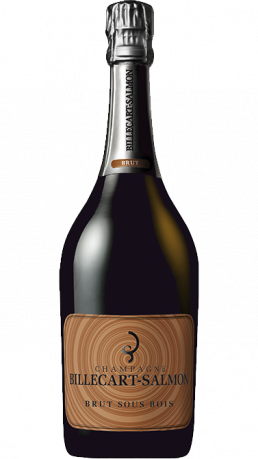
Billecart-Salmon Brut Sous Bois NV
Captivating & Original
This could almost be considered the little brother of the Clos St Hilaire: along with that wine this is 100% barrel-fermented and these are the only ones in the range that are. With one-third each of the three main grape varieties and the malolactic fermentation is blocked, it’s a truly fascinating wine. “It sings with Billecart precision, while basking in the richness of barrel fermentation, silky and alluring, confronting, and commanding, all at once. Don’t serve it too cold and give it lots of air in a large glass” extols champagne specialist Tyson Stelzer.
Taut and vivid with bright cherry fruit, some lively citrus, and a touch of spice. Pristine with lovely intensity and a nice savouriness, finishing bright and complex, with lovely tension on the finish. A gastronomic Champagne.
94 points – Dr Jamie Goode, Wine Anorak
The Billecart-Salmon Sous Bois is one of the best non-vintage Bruts in the marketplace. This Champagne is rich and racy. Its lively aromas and flavors of mineral notes and bright stone fruits should pair superbly with oven-roast chicken over a mix of arugula and kale.
95 points – Wilfred Wong of Wine.com
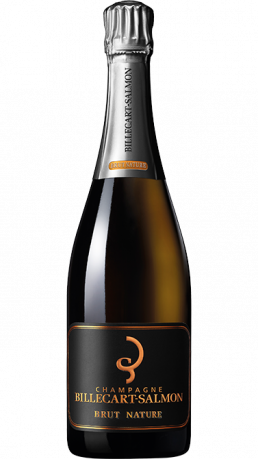
Billecart-Salmon Brut Nature
Pure & Refined
A dense, layered Champagne with a full body and lots of creamy texture. Lovely, cooked apple and pie crust. 40% Pinot Meunier, 30% chardonnay and 30% pinot noir. The base was 2015, but in total it contains 10 harvests. It was bottled at the beginning of 2016 and disgorged in March 2020. Four years on lees. Fantastic release.
94 points – James Suckling
The Billecart-Salmon Brut Nature Champagne is at once rewarding and teeth-biting, as well as delicious and lasting. This wine brings a streak of minerality to the fore with its aromas and flavors. Enjoy its tantalizing stone fruit flavors and generous palate-feel with tuna tartare and a squeeze of Meyer lemon.
93 points – Wilfred Wong of Wine.com
The holiday season will be on us before we know it. With the continued global demand for Champagne, the time to stock up is now. AND – DON’T FORGET – Dhall & Nash has LARGE FORMAT STOCK available!!! Grab these titanic Champagne masterpieces and get ready to captivate a room with each pull of the cork!
